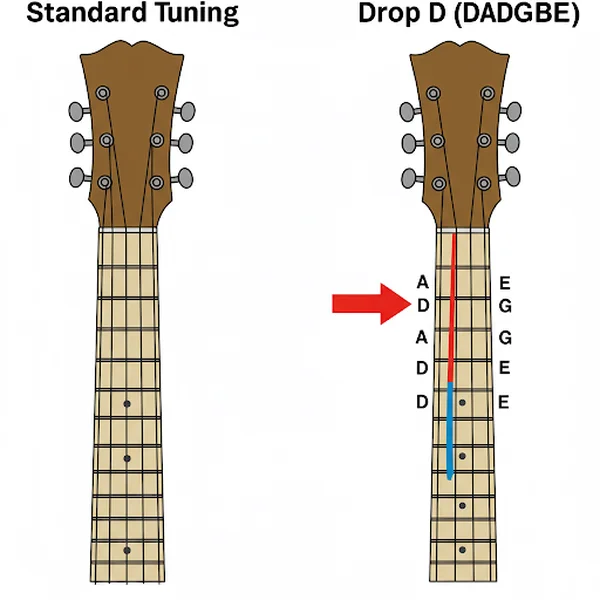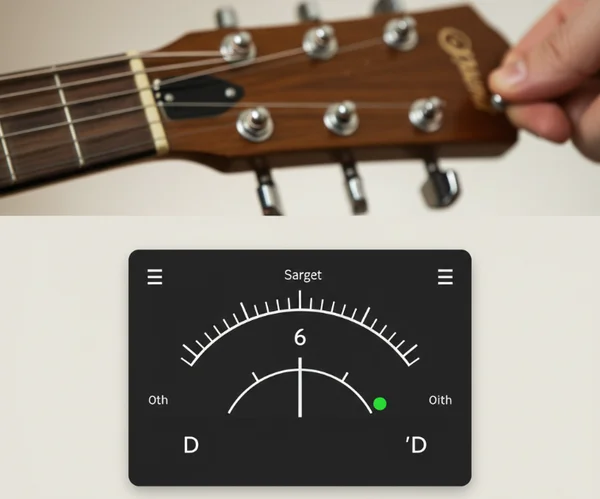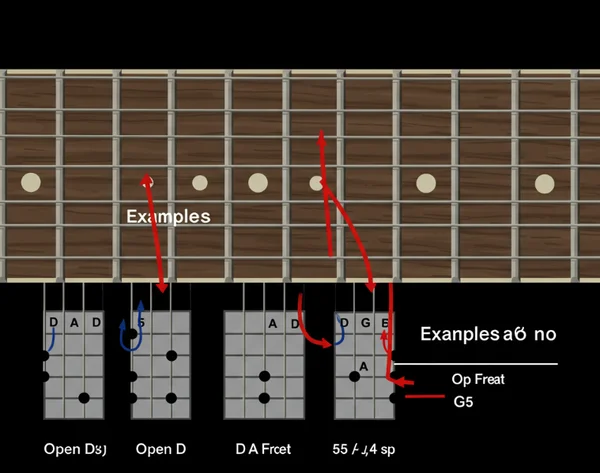ヘヴィサウンド入門:ギタリストのためのDrop Dチューニングとチューニング方法
お気に入りのロックやメタルバンドが、あの地を揺るがすようなヘヴィなギターリフをどのように実現しているのか、疑問に思ったことはありませんか? 多くの場合、その秘密は ギターチューニング にあり、そのパワフルなサウンドを実現するための最も人気のあるオルタナティブチューニングの1つが Drop Dチューニング です。しかし Drop Dチューニングとは何か、そしてどのようにしてこの音響兵器を自分の演奏のために活用できるのでしょうか? このガイドでは、基本事項を理解することから、簡単な オンラインチューナー を使用した Drop Dチューニング方法 を学ぶことまで、知っておくべきことをすべて説明します。ヘヴィな音楽の新たな次元を探求する準備はできていますか?
ギターのためのDrop Dチューニングとは何か
では、Drop Dチューニング は、ほとんどのギタリストが最初に使用する標準チューニングと何が違うのでしょうか? 驚くほどシンプルでありながら、非常に効果的な変更です。
標準チューニングとDrop D:重要な違い
ほとんどのギターは 標準EADGBE にチューニングされており、弦は低音(太い)から高音(細い)にかけてE、A、D、G、B、Eとなります。Drop Dチューニング では、最低音のE弦のみを変更します。この 低音E弦 を完全4度下げてDにします。他の5本の弦(A、D、G、B、E)は、標準チューニングとまったく同じです。

DADGBE音程構成の理解
この単純な変更により、ギターのチューニングは DADGBEチューニング に変わります。つまり、最低音の3本の弦は、オープンで演奏するとD5パワーコード(D-A-D)を形成します。これは、後で説明するように、Drop Dがヘヴィな音楽で非常に人気のある理由の基礎となっています。多くのギタリストは、この オルタナティブチューニング が新たな創造的な道を切り開くと感じています。
ギターをDrop Dにチューニングする方法
ヘヴィなジャンルに進出するなら、Drop Dチューニング方法 を学ぶことは基本的なスキルです。信頼できるチューナーがあれば、思っているより簡単です。方法は次のとおりです。
標準EADGBEチューニングから始める
まず、ギターを 標準EADGBE にチューニングします。これは、6弦目を変更するための正しい基準点となります。自信がない場合は、正確なギターチューニングツール を使用することを強くお勧めします。
低音E弦の特定
低音E弦 はギターで最も太い弦で、楽器を演奏姿勢で持っているとき、あなたに最も近い弦です。これは、Drop Dチューニング で調整する唯一の弦です。
正確なDrop Dのためのオンラインチューナー(Tuner.wikiなど)の使用
オンラインチューナー は、これを行うための非常に便利なツールです。マイクへのアクセスを許可するだけで、弦の音高を検出します。Drop Dチューニング では、最低音の弦でD2音(中央Cの下のD音)を目指します。多くのミュージシャンは、迅速な ダウンチューニング にこの方法を好んでいます。

6弦目をDにチューニングする
低音E弦をはじいてチューナーを見てください。その弦のチューニングペグをゆっくり回して緩めます(通常は反時計回りですが、これは異なる場合があります)。弦をはじき続け、チューナーがD音に達したことを示すまで調整します。やりすぎないように注意して時間をかけてください。
他の弦をチェックする
低音E弦がDにチューニングされたら、他の5本の弦(A、D、G、B、E)のチューニングをすばやく確認して、その過程で不注意にチューニングが狂っていないことを確認します。それらは標準ピッチのままである必要があります。
Drop Dチューニングを使用する理由:ロックとメタルギタリストのためのメリット
Drop Dチューニング方法 を知った今、あなたはこう尋ねるかもしれません:Drop Dチューニングのメリット、特に ロックギター と メタルギターチューニング にとっての実際のメリットは何でしょうか?
よりヘヴィで厚みのあるサウンドを実現
最も直接的なメリットは ヘヴィサウンド です。より低いD音は、低音域にかなりのパンチと共鳴を加え、リフをより豊かでパワフルなものにします。これは、重量感のあるギターの存在に依存する多くの 音楽ジャンル の特徴です。
より簡単なワンフィンガーパワーコード
DADGBEチューニング の最大の実際的な利点の1つは、最低音の3本の弦で パワーコード を1本の指だけで演奏できることです。D、A、Dの弦はオープンでD5パワーコードを形成するため、これらの3本の弦の任意のフレットで指をバーするだけで、可動式パワーコードを作成できます。これにより、速くて分厚いリズム演奏がはるかに簡単になります。

Drop Dチューニングを使用する一般的なジャンル(メタル、ハードロックなど)
Drop Dチューニング は、次のようなロックとメタルの多くのサブジャンルで広く使用されています。
- ニューメタル
- メタルコア
- ポストグランジ
- オルタナティブメタル
- ハードロック
その汎用性により、幅広いヘヴィなスタイルで定番となっています。これらのジャンルの ギターを学ぶ リフを演奏したい場合は、Drop Dを理解することが不可欠です。
Drop Dでの演奏:始めるための基本的なコードとリフ
これで Drop Dチューニング に成功裏にチューニングできました。では、Drop Dでの演奏方法 は? 基本的な要素を見てみましょう。
必須Drop Dパワーコード(D5、G5、A5など)
前述のように、DADGBEチューニング の美しさは、下の3本の弦におけるシンプルなパワーコードにあります。
- Open D5: 最低音の3本の弦をオープンで演奏します(D-A-D)。
- E5: 最低音の3本の弦の2フレットをバーします。
- F5: 最低音の3本の弦の3フレットをバーします。
- G5: 最低音の3本の弦の5フレットをバーします。 ネックを上に向かって同様に!これにより、ヘヴィな パワーコード 間の移行が非常にスムーズになります。
練習のための簡単なリフのアイデア
これらのワンフィンガーパワーコードを使って実験してみましょう。D、A、Dの弦で異なるフレット間を移動するシンプルなリズムパターンを作成してみましょう。低音D弦が ギターリフ に重みを加えているのを聞いてみてください。 Drop Dチューニング では、シンプルなパターンでも大音量で聞こえることがあります。
低音Dによるメロディの可能性を探る
低音D弦は、パワーコードだけでなく、メロディラインやベースノートにも使用できることを忘れないでください。単音リフに取り入れてみたり、高音弦でメロディーを演奏している間、ドローンノートとして使用してみたりしてください。この オルタナティブチューニング は、単なるチャグだけでなく、さらに多くのものを提供します。探求中に正確にチューニングするには、オンラインツールを確認してください。
Drop Dギターチューニングであなたのヘヴィな一面を開放しよう
Drop Dチューニング は単なる オルタナティブチューニング ではありません。それは、よりヘヴィでパワフルなギターサウンドと、ロックやメタルで特に多くの新しい創造の可能性への入り口です。DADGBE構成の理解から、Drop Dチューニング方法 の習得、そしてその象徴的なリフと パワーコード の探求まで、あなたは飛び込むための基礎知識を身につけました。
さあ、何を待っているのですか? ギターを取り、Tuner wikiにアクセスして 無料で使いやすいオンラインチューナーを使用し、今日から Drop Dギターチューニング を試してみましょう。あなたの演奏に新たな一面を開花させることができるかもしれません!
Drop Dチューニングに関するよくある質問
ギタリストが Drop Dチューニング について持つよくある質問をいくつかご紹介します。
Drop Dチューニングに通常のギター弦を使用できますか?
はい、Drop Dチューニング には、通常は標準の ギター弦 を使用できます。1本の弦だけが完全4度下げられるため、ほとんどの標準的な弦ゲージは、過度にたるむことなく対応できます。ただし、Drop Dやさらに低いチューニングに頻繁に留まる予定がある場合は、より良いテンションとトーンのために、少し重いゲージの弦を検討するかもしれません。
Drop Dチューニングはギターネックを傷つけますか?
いいえ、Drop Dチューニング 自体は、適切にセットアップされたギターネックを傷つけることはありません。1本の弦が緩いため、ネック全体のテンションはわずかに低下します。非常に異なるチューニング間を頻繁に大幅に変更すると、時間の経過とともにトラスロッドの調整が必要になる可能性がありますが、標準からDrop Dに単純に移行するのは、一般的に非常に安全です。
Drop DチューニングとDスタンダードチューニングの違いは何ですか?
これはよくある混乱点です。Drop Dチューニング では、低音E弦だけがDにダウンチューニングされ、DADGBEになります。Dスタンダードチューニング(DGCFAD)では、すべての6本の弦 が標準EADGBEから完全4度下げられます。Dスタンダードは、Drop Dよりもはるかに低い全体的なチューニングです。Dスタンダードにチューニングする必要がある場合は、正確なオンライン楽器チューナー が非常に役立ちます。
Drop Dチューニングは初心者向けですか?
標準チューニングは通常、出発点として推奨されますが、ロックやメタルに興味のある初心者にとって、Drop Dチューニング は実際には非常にアクセスしやすいものです。ワンフィンガーパワーコードは、ヘヴィなリズムの演奏を容易にします。ただし、初心者にとって、ほとんどのギター音楽と理論の基礎となる 標準EADGBE チューニングを最初に理解しておくことは依然として重要です。標準に慣れてからDrop Dを探求することは、楽しい次のステップとなる可能性があります。
チューニングを切り替える場合、どのくらいの頻度でDrop Dに再チューニングする必要がありますか?
標準と Drop Dチューニング を頻繁に切り替える場合は、毎回再チューニングする必要があります。Tuner.wikiの無料オンラインチューナーのような信頼性が高く迅速なチューナーを使用すると、このプロセスがはるかに高速になり、手間が少なくなり、 ギター演奏 により集中できます。